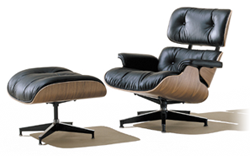Design Classics
Lounge Chair and
Ottoman, 1956
Designer: Charles Eames
Manufacturer: Herman Miller

From his studio in Santa Monica, Charles Eames helped shift the centre of gravity of American design from New York to California. Together with his wife and partner, Ray, he created an astounding array of ground-breaking and award-winning designs, from houses and exhibits to books, toys, films and furniture.
WHAT
The legendary lounge chair features leather cushions cradled in lustrous rosewood shells that form the arms, seat, back and head rest. The generously proportioned structure sits on a stable five-star cast-aluminium base so you can swivel and tilt to your heart’s content without looking off-centre of tipping over. It all arrives knocked down and can be set up by one person using a screwdriver – a process made famous in a promotional film showing Ray Eames assembling the chair in fast motion and then lounging in it in slow motion.
WHEN
Eames was fascinated with the possibilities of molded plywood. At a time when plastic was rudimentary, bent wood was one of the only ways to mass-produce curved shapes. The result was several innovative products including a splint used for battlefield emergencies and a series of chairs. Eames designed the lounge chair in 1956, and one of the originals was a birthday gift to Billy Wilder, the director of films such as Sunset Boulevard and Some Like It Hot.
WHY
The 50th anniversary of Eames’s elegant and coveted chair is being celebrated in 2006 with a travelling exhibit and a special numbered edition. Designed in an era when domestic comfort typically meant a reclining La-Z-Boy, this chair is unapologetically luxurious and modern with its fine wood (endangered rose wood was soon replaced with environmentally sustainable alternatives) and its permanently wrinkled and cosseting leather upholstery. Eames claimed that all he wanted to do was create a chair that had the “warm, receptive look of a well-used first-baseman’s mitt.”
National Post, March 16, 2006
